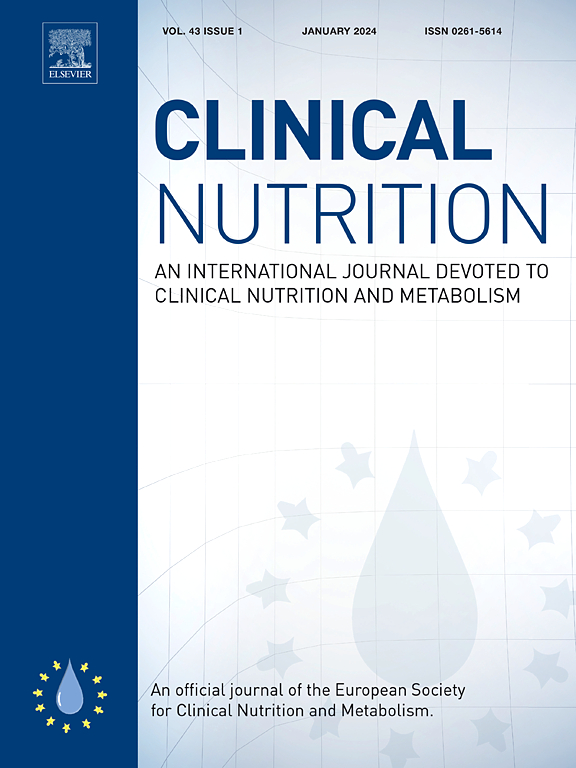Six weeks of time-restricted eating improves basal fat oxidation and body composition but not fat oxidation during exercise in young males
IF 6.6
2区 医学
Q1 NUTRITION & DIETETICS
引用次数: 0
Abstract
Background & aims
Time-restricted eating (TRE) is a type of intermittent fasting, requiring individuals to limit their eating timeframe to specific hours in the day, while maintaining a fasting period greater than 12 h. Fat oxidation (FOx) is a critical determinant in the pathophysiology of metabolic diseases, with impaired FOx contributing to conditions such as insulin resistance and obesity, whereas enhanced FOx is associated with improved metabolic health. However, the impact of the 16:8 TRE model on FOx remains largely unexplored. The aim of this study was to determine the effect of a 6-week TRE on resting and exercise substrate oxidation, body composition, and blood markers related to metabolic health.
Methods
Thirty-three healthy, young males (age: 27.5 ± 6 years, body mass: 76.5 ± 8.4 kg, maximal oxygen uptake [O2max]: 43.9 ± 6.6 mL·kg−1·min−1) were assigned to either TRE (n = 16) or control group (n = 17), with efforts to match baseline characteristics, including O2max and body composition. The TRE group followed a 16:8 program for 6 weeks, while controls maintained their existing dietary habits. Body composition, blood glucose, insulin, blood lipids, resting substrate oxidation, and FOx during cycling at 40 % O2max were assessed before and after the 6-week period. Data were analyzed using both intention-to-treat (ITT) and per-protocol approaches.
Results
Thirty-three participants were included in the ITT analysis, while 31 participants were included in the per-protocol analysis. Compared to baseline, results showed a significant difference (p < 0.05) between TRE and control groups in body mass (TRE versus control) (Δ = −2.8 kg versus Δ = 0.7 kg), fat mass (Δ = −1.4 kg versus Δ = 0.4 kg), percent body fat (−1.7 % versus 0.4 %), lean mass (Δ = −1.4 kg versus Δ = 0.3 kg), and visceral adipose tissue mass (Δ = −39.7 g versus Δ = 46.4 g). There was a significant difference between TRE and control groups in resting respiratory exchange ratio (RER, Δ = −0.02 versus Δ = 0.02; p = 0.016), FOx (Δ = 0.33 mg·kg FFM−1·min−1 versus Δ = −0.37 mg·kg FFM−1·min−1; p = 0.007), and carbohydrate oxidation (Δ = −0.39 mg·kg FFM−1·min−1 versus Δ = 0.45 mg·kg FFM−1·min−1; p = 0.037) after the 6-week period. Exercise substrate oxidation and fasting blood glucose, insulin, triglycerides, total cholesterol, and high-density lipoprotein cholesterol did not significantly change over time in either group (p > 0.05).
Conclusions
In summary, a 6-week TRE significantly reduces body mass, fat mass, and resting RER as well as increases resting FOx in young, healthy males. However, it does not affect blood markers related to cardiometabolic health or exercise substrate oxidation.
This trial was registered at https://clinicaltrials.gov/study/NCT06498102asNCT06498102.
六周的限时饮食改善了年轻男性运动期间的基础脂肪氧化和身体成分,但没有改善脂肪氧化
背景,限时进食(TRE)是一种间歇性禁食,要求个体将进食时间限制在一天中的特定时间内,同时保持超过12小时的禁食期。脂肪氧化(FOx)是代谢疾病病理生理学的关键决定因素,FOx受损会导致胰岛素抵抗和肥胖等疾病,而FOx增强则与代谢健康改善有关。然而,16:8 TRE模式对FOx的影响在很大程度上仍未被探索。本研究的目的是确定为期6周的TRE对静息和运动底物氧化、身体成分和与代谢健康相关的血液标志物的影响。方法33名健康年轻男性(年龄:27.5±6岁,体重:76.5±8.4 kg,最大摄氧量[V˙O2max]: 43.9±6.6 mL·kg−1·min−1)分为TRE组(n = 16)和对照组(n = 17),努力匹配基线特征,包括V˙O2max和身体成分。TRE组遵循16:8的饮食计划6周,而对照组保持现有的饮食习惯。在40% V˙O2max条件下,对6周前后的体成分、血糖、胰岛素、血脂、静息底物氧化和FOx进行评估。数据分析采用意向治疗(ITT)和每协议方法。结果ITT分析纳入33名受试者,per-protocol分析纳入31名受试者。与基线相比,结果显示有显著差异(p <;在体重(Δ =−2.8 kg对Δ = 0.7 kg)、脂肪质量(Δ =−1.4 kg对Δ = 0.4 kg)、体脂百分比(−1.7%对0.4%)、瘦体重(Δ =−1.4 kg对Δ = 0.3 kg)和内脏脂肪组织质量(Δ =−39.7 g对Δ = 46.4 g)方面,TRE组和对照组之间的差异为0.05。TRE组与对照组静息呼吸交换率(RER, Δ =−0.02 vs Δ = 0.02)差异有统计学意义;p = 0.016), FOx (Δ = 0.33 mg·kg FFM−1·min−1 vs Δ = - 0.37 mg·kg FFM−1·min−1;p = 0.007),碳水化合物氧化(Δ = - 0.39 mg·kg FFM−1·min−1 vs Δ = 0.45 mg·kg FFM−1·min−1;P = 0.037)。两组的运动底物氧化和空腹血糖、胰岛素、甘油三酯、总胆固醇和高密度脂蛋白胆固醇随时间没有显著变化(p >;0.05)。综上所述,6周的TRE显著降低了年轻健康男性的体质量、脂肪质量和静息RER,并增加了静息FOx。然而,它不影响与心脏代谢健康或运动底物氧化相关的血液标志物。该试验已在https://clinicaltrials.gov/study/NCT06498102asNCT06498102注册。
本文章由计算机程序翻译,如有差异,请以英文原文为准。
求助全文
约1分钟内获得全文
求助全文
来源期刊

Clinical nutrition
医学-营养学
CiteScore
14.10
自引率
6.30%
发文量
356
审稿时长
28 days
期刊介绍:
Clinical Nutrition, the official journal of ESPEN, The European Society for Clinical Nutrition and Metabolism, is an international journal providing essential scientific information on nutritional and metabolic care and the relationship between nutrition and disease both in the setting of basic science and clinical practice. Published bi-monthly, each issue combines original articles and reviews providing an invaluable reference for any specialist concerned with these fields.
 求助内容:
求助内容: 应助结果提醒方式:
应助结果提醒方式:


